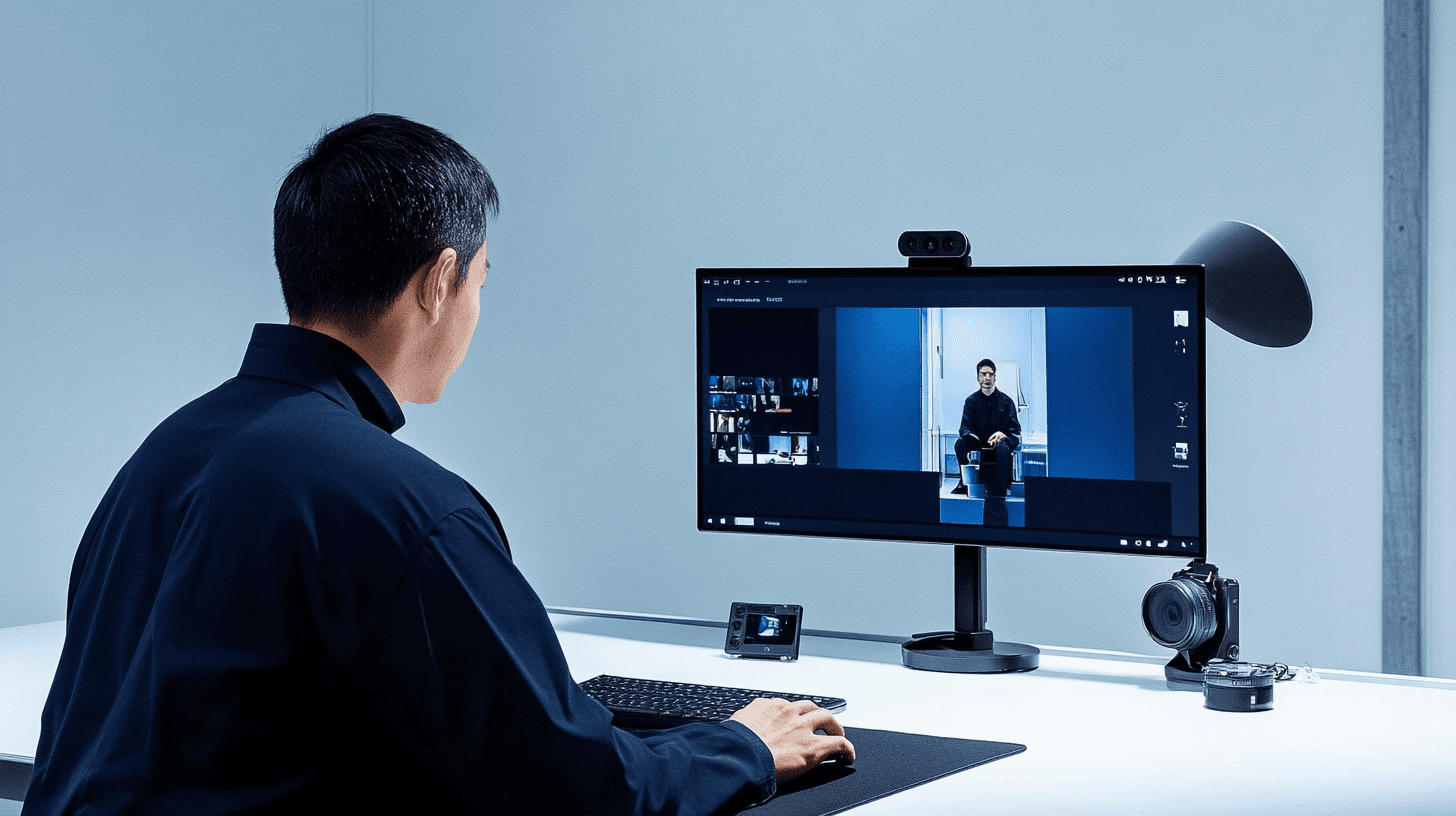Instructor Led Videos
The Ultimate Guide To Making Instructor Led Videos For Corporate Training
The Ultimate Guide To Making Instructor Led Videos For Corporate Training
Discover the power of Instructor-Led Videos (ILVs) for corporate training. This comprehensive guide covers everything from ILV basics to advanced production techniques, helping you create engaging and effective learning experiences for your organization.
Discover the power of Instructor-Led Videos (ILVs) for corporate training. This comprehensive guide covers everything from ILV basics to advanced production techniques, helping you create engaging and effective learning experiences for your organization.
Rahul Maurya
September 18, 2024


In the ever-evolving landscape of corporate learning, Instructor-Led Videos (ILVs) have emerged as a powerful tool for delivering effective, engaging, and scalable training. This comprehensive guide will walk you through everything you need to know about ILVs, from their definition and benefits to best practices in creation and implementation.
What are Instructor-Led Videos (ILVs)?
Instructor-Led Videos (ILVs) are a dynamic format in online learning where an instructor speaks directly to the camera about a topic, supported by various audio and visual aids. ILVs strike a balance between the human element of traditional classroom training and the technological advantages of eLearning, making them particularly effective for corporate training scenarios.
Types of ILVs
Basic ILVs: These feature an instructor teaching without extensive visual effects. This format is particularly effective when you have a star presenter or field expert whose presence alone can captivate the audience.
Enhanced ILVs: These incorporate a range of audio-visual aids and effects to create a more immersive learning experience.
The ILV Production Process
Creating effective ILVs involves three main stages:
1. Pre-production
Lesson Planning: This outlines the topic coverage, props, discussion points, examples, and visual aids to be used.
ILV Scripting: A detailed document that includes both the speech content and visual elements.
2. Production
The actual audiovisual recording takes place.
Can be done with basic equipment at home or in a professional studio.
Often involves multiple takes and versions of scenes.
3. Post-production
Selection and organization of the best recorded clips.
Addition of sound effects, background music, visual effects, on-screen text, and motion graphics.
Key Components of Effective ILVs
Instructor Presentation
Positioning: The instructor should be placed centrally if they're the sole focus, or on the right side if sharing screen space with visual aids.
Framing: Maintain a balanced distance from screen edges to avoid creating viewer anxiety.
Costume: Choose attire that's undistracting and thematically coherent with the content.
Delivery: Vary the tone of instruction to maintain engagement and humanize the learning experience.
Background and Set Design
Lighting: Ensure proper illumination, avoiding visible shadows.
Visual Aids: Dedicate a consistent space for non-fullscreen visual aids, typically on the left side of the screen.
Multiple Settings: Use different backgrounds to signify transitions between content sections.
Audio Elements
Voiceover: Useful for sections without an on-screen instructor, navigation instructions, or brief introductions/conclusions.
Background Music: When appropriate, can enhance the learning atmosphere and maintain engagement.
Visual Elements
On-screen Text (OST): Use to reinforce key points, but avoid overcrowding the screen.
Typography: Maintain consistent font styles and sizes for similar types of content.
Iconography: Use familiar icons consistently and label new ones clearly.
Motion Graphics: Implement to highlight key points, visualize abstract concepts, or guide viewer attention.
Synchronization
Ensure all elements (audio, visual, text) are perfectly timed to enhance rather than distract from the learning experience.
Advanced Post-production Techniques
Video Editing: Create smooth transitions between scenes for a polished final product.
Color Correction and Grading: Ensure visual consistency across all footage.
Interactive Elements: Incorporate quizzes or clickable elements to boost engagement.
Benefits of ILVs in Corporate Training
Engagement: ILVs combine the best of human instruction with technological enhancements, creating a highly engaging learning experience.
Flexibility: Learners can access the content at their own pace and revisit as needed.
Consistency: Ensures all learners receive the same high-quality instruction.
Scalability: Once created, ILVs can be distributed to any number of learners.
Cost-effectiveness: Reduces the need for in-person training sessions, especially for geographically dispersed teams.
Implementing ILVs in Your Corporate Training Program
Identify Suitable Topics: Not all training is suited for ILVs. Choose topics that benefit from visual demonstration and expert explanation.
Invest in Quality: While it's possible to create ILVs with basic equipment, investing in good audio-visual quality pays off in learner engagement.
Train Your Trainers: Ensure your instructors are comfortable and effective on camera.
Integrate with Other Learning Methods: Use ILVs as part of a blended learning approach for maximum impact.
Gather and Act on Feedback: Continuously improve your ILVs based on learner feedback and performance metrics.
By leveraging the power of Instructor-Led Videos, you can create a more engaging, effective, and efficient corporate training program. As with any learning tool, the key to success lies in thoughtful implementation and continuous improvement.
In the ever-evolving landscape of corporate learning, Instructor-Led Videos (ILVs) have emerged as a powerful tool for delivering effective, engaging, and scalable training. This comprehensive guide will walk you through everything you need to know about ILVs, from their definition and benefits to best practices in creation and implementation.
What are Instructor-Led Videos (ILVs)?
Instructor-Led Videos (ILVs) are a dynamic format in online learning where an instructor speaks directly to the camera about a topic, supported by various audio and visual aids. ILVs strike a balance between the human element of traditional classroom training and the technological advantages of eLearning, making them particularly effective for corporate training scenarios.
Types of ILVs
Basic ILVs: These feature an instructor teaching without extensive visual effects. This format is particularly effective when you have a star presenter or field expert whose presence alone can captivate the audience.
Enhanced ILVs: These incorporate a range of audio-visual aids and effects to create a more immersive learning experience.
The ILV Production Process
Creating effective ILVs involves three main stages:
1. Pre-production
Lesson Planning: This outlines the topic coverage, props, discussion points, examples, and visual aids to be used.
ILV Scripting: A detailed document that includes both the speech content and visual elements.
2. Production
The actual audiovisual recording takes place.
Can be done with basic equipment at home or in a professional studio.
Often involves multiple takes and versions of scenes.
3. Post-production
Selection and organization of the best recorded clips.
Addition of sound effects, background music, visual effects, on-screen text, and motion graphics.
Key Components of Effective ILVs
Instructor Presentation
Positioning: The instructor should be placed centrally if they're the sole focus, or on the right side if sharing screen space with visual aids.
Framing: Maintain a balanced distance from screen edges to avoid creating viewer anxiety.
Costume: Choose attire that's undistracting and thematically coherent with the content.
Delivery: Vary the tone of instruction to maintain engagement and humanize the learning experience.
Background and Set Design
Lighting: Ensure proper illumination, avoiding visible shadows.
Visual Aids: Dedicate a consistent space for non-fullscreen visual aids, typically on the left side of the screen.
Multiple Settings: Use different backgrounds to signify transitions between content sections.
Audio Elements
Voiceover: Useful for sections without an on-screen instructor, navigation instructions, or brief introductions/conclusions.
Background Music: When appropriate, can enhance the learning atmosphere and maintain engagement.
Visual Elements
On-screen Text (OST): Use to reinforce key points, but avoid overcrowding the screen.
Typography: Maintain consistent font styles and sizes for similar types of content.
Iconography: Use familiar icons consistently and label new ones clearly.
Motion Graphics: Implement to highlight key points, visualize abstract concepts, or guide viewer attention.
Synchronization
Ensure all elements (audio, visual, text) are perfectly timed to enhance rather than distract from the learning experience.
Advanced Post-production Techniques
Video Editing: Create smooth transitions between scenes for a polished final product.
Color Correction and Grading: Ensure visual consistency across all footage.
Interactive Elements: Incorporate quizzes or clickable elements to boost engagement.
Benefits of ILVs in Corporate Training
Engagement: ILVs combine the best of human instruction with technological enhancements, creating a highly engaging learning experience.
Flexibility: Learners can access the content at their own pace and revisit as needed.
Consistency: Ensures all learners receive the same high-quality instruction.
Scalability: Once created, ILVs can be distributed to any number of learners.
Cost-effectiveness: Reduces the need for in-person training sessions, especially for geographically dispersed teams.
Implementing ILVs in Your Corporate Training Program
Identify Suitable Topics: Not all training is suited for ILVs. Choose topics that benefit from visual demonstration and expert explanation.
Invest in Quality: While it's possible to create ILVs with basic equipment, investing in good audio-visual quality pays off in learner engagement.
Train Your Trainers: Ensure your instructors are comfortable and effective on camera.
Integrate with Other Learning Methods: Use ILVs as part of a blended learning approach for maximum impact.
Gather and Act on Feedback: Continuously improve your ILVs based on learner feedback and performance metrics.
By leveraging the power of Instructor-Led Videos, you can create a more engaging, effective, and efficient corporate training program. As with any learning tool, the key to success lies in thoughtful implementation and continuous improvement.

Optimizing Instructor-Led Videos: From Signposting to SCORM
Rahul Maurya
Sep 27, 2024

Advanced Production Techniques for High-Impact Instructor-Led Videos
Rahul Maurya
Sep 27, 2024

Implementing Instructor-Led Videos for Effective Leadership Development in Corporations
Abhishek Doshi
Sep 22, 2024
247Learnerco Pvt. Ltd.
WeWork Salarpuria Symbiosis,
Bannerghatta Road, Arakere,
Bengaluru - 560076

Sign up for our newsletter and stay updates with the latest in learning sciences
Sign up for our newsletter and stay updates with the latest in learning sciences
247Learnerco Pvt. Ltd.
WeWork Salarpuria Symbiosis,
Bannerghatta Road, Arakere,
Bengaluru - 560076
247Learnerco Pvt. Ltd.
WeWork Salarpuria Symbiosis,
Bannerghatta Road, Arakere,
Bengaluru - 560076